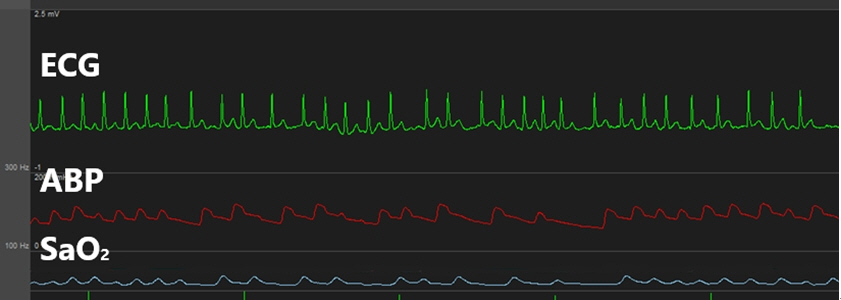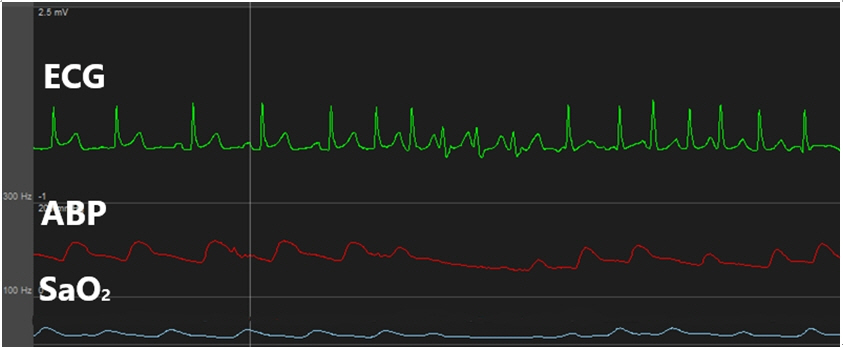Anesth Pain Med.
2021 Jul;16(3):284-289. 10.17085/apm.21008.
Tachycardia-polyuria syndrome after swan-ganz catheterization in liver transplant patient - A case report -
- Affiliations
-
- 1Department of Anesthesiology and Pain Medicine, Seoul Medical Center, Seoul, Korea
- 2Department of Anesthesiology and Pain Medicine, Laboratory for Cardiovascular Dynamics, Asan Medical Center, University of Ulsan College of Medicine, Seoul, Korea
- KMID: 2519058
- DOI: http://doi.org/10.17085/apm.21008
Abstract
- Background
Tachycardia-polyuria syndrome is characterized by polyuria occurring because of tachycardia with a heart rate of ≥ 120 beats/min lasting ≥ 30 min. We report such a case occurring after swan-ganz catheterization. Case: A 41-year-old male was scheduled for living-donor liver transplantation. After general anesthesia, atrial fibrillation occurred during swan-ganz catheterization, and polyuria developed 1 h later. During the anhepatic phase, the patient’s heart rate increased further, and cardioversion was performed. After a normal sinus rhythm was achieved, the patient’s urine output returned to normal.
Conclusions
The patient’s polyuria seemed related to the iatrogenic atrial fibrillation occurring during swan-ganz catheterization. Although we did not measure atrial natriuretic peptide, an increase in its concentration may have been the main mechanism of polyuria, as natriuresis was observed.
Keyword
Figure
Reference
-
1. Wood P. Polyuria in paroxysmal tachycardia and paroxysmal atrial flutter and fibrillation. Br Heart J. 1963; 25:273–82.2. Kinney MJ, Stein RM, DiScala VA. The polyuria of paroxysmal atrial tachycardia. Circulation. 1974; 50:429–35.3. Luria MH, Adelson EI, Lochaya S. Paroxysmal tachycardia with polyuria. Ann Intern Med. 1966; 65:461–70.4. Hirata Y, Nozaki A, Toda I, Murakawa Y, Sugimoto T, Matsuoka H, et al. Plasma concentration of atrial natriuretic polypeptide in patients with atrial tachycardia. Jpn Heart J. 1987; 28:53–61.5. Nilsson G, Pettersson A, Hedner J, Hedner T. Increased plasma levels of atrial natriuretic peptide (ANP) in patients with paroxysmal supraventricular tachyarrhythmias. Acta Med Scand. 1987; 221:15–21.6. Zullo MA. Atrial regulation of intravascular volume: observations on the tachycardia-polyuria syndrome. Am Heart J. 1991; 122(1 Pt 1):188–94.7. Canepa-Anson R, Williams M, Marshall J, Mitsuoka T, Lightman S, Sutton R. Mechanism of polyuria and natriuresis in atrioventricular nodal tachycardia. Br Med J (Clin Res Ed). 1984; 289:866–8.8. Fujii T, Kojima S, Imanishi M, Ohe T, Omae T. Different mechanisms of polyuria and natriuresis associated with paroxysmal supraventricular tachycardia. Am J Cardiol. 1991; 68:343–8.9. Paintal AS. A study of right and left atrial receptors. J Physiol. 1953; 120:596–610.10. Nigro N, Grossmann M, Chiang C, Inder WJ. Polyuria-polydipsia syndrome: a diagnostic challenge. Intern Med J. 2018; 48:244–53.11. White CW, Kerber RE, Weiss HR, Marcus ML. The effects of atrial fibrillation on atrial pressure-volume and flow relationships. Circ Res. 1982; 51:205–15.12. Treschan TA, Peters J. The vasopressin system: physiology and clinical strategies. Anesthesiology. 2006; 105:599–612; quiz 639-40.13. Cantin M, Genest J. The heart and the atrial natriuretic factor. Endocr Rev. 1985; 6:107–27.14. Laragh JH. The endocrine control of blood volume, blood pressure and sodium balance: atrial hormone and renin system interactions. J Hypertens Suppl. 1986; 4:S143–56.15. O'Brien B, Burrage PS, Ngai JY, Prutkin JM, Huang CC, Xu X, et al. Society of Cardiovascular Anesthesiologists/European Association of Cardiothoracic Anaesthetists practice advisory for the management of perioperative atrial fibrillation in patients undergoing cardiac surgery. J Cardiothorac Vasc Anesth. 2019; 33:12–26.
- Full Text Links
- Actions
-
Cited
- CITED
-
- Close
- Share
- Similar articles
-
- Right ventricle perforation after Swan-Ganz catheterization in a patient undergoing CABG surgery: A case report
- Pulmonary alveolar hemorrhage from a pulmonary artery false aneurysm after Swan-Ganz catheterization in a thoracic aortic aneurysm patient: a case report
- A Case of Swan-Ganz Catheter Malposition: A case report
- Comparisons of the Oxygen Saturation Between Right Atrial and Pulmonary Arterial Blood Immediately After Emergence from Cardiopulmonary Bypass During Open Heart Surgery in Pediatric Patients
- Secondary migration of a pre-existing central venous catheter due to a Swan-Ganz catheter insertion – A case report –





